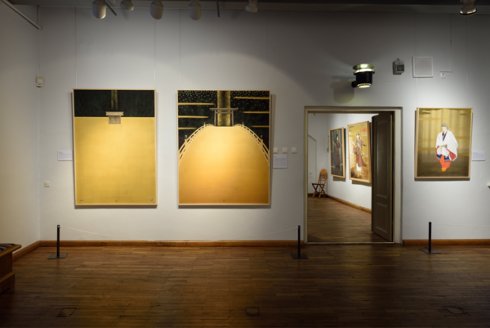Torii Rei Exhibition in Berlin
Exhibition of Works by Torii Rei to Mark the G7 Summit
June 22nd, 2016The ‘Museum für Asiatische Kunst’ is showing an exhibition with paintings by Torii Rei to mark the G7 summit meeting held in Ise, Japan, on the 26th and 27th of May 2016. The exhibition is under patronage of the Japanese Embassy and the ‘Japanisch-Deutsches Zentrum’ in Berlin.
This was the first presentation of the site-specific cycle of fifteen paintings by Torii Rei, which were created exclusively for Berlin. In his work the painter focused on the extensive grounds of the shrine complex in Ise. Related to Japan's Imperial institution, it is situated close to the eponymous city, in Mie Prefecture.
Ise Jingu (The Ise Grand Shrine) is the main Shinto Shrine of Japan, and the temples and buildings are not accessible to all pilgrims or to tourists. Entrance to the main sanctuary is permitted only to members of the Imperial family and to servants of the cult's highest rank. Shinto is a Japanese religious practice associated with the numinous beings known in Japanese as Kami.
Kami are characteristically manifested in rocks, trees and waterfalls. Specifically for this exhibition, Torii created an immersive painterly indoor installation, which invites visitors to explore sustainable harmony between humanity and nature. Torii believes this is manifested through the Shinto faith.
Torii Rei is a remarkable Japanese artist. He was born in 1952 and graduated from Musashino Art Univeristy in 1974. Ever since he has worked as a freelance 日本画家 ‘Nihongaka’ (Japanese Painter), artist and writer. He studied Japanese legends and traditional culture for several decades. Torii Rei’s large-scale paintings are on display in numerous Japanese shrines and temples (the Suwa Taisha Kamisha Shrine, the Daienji Temple, the Okuni Shrine, the Mishima Taisha Shrine etc.), as well as in the festive halls of public buildings.
His works have been exhibited in several Shintō museums.
Visitors will be able to see the exhibition until January 8th of 2017 at Museum fur Asiatische Kunst Berlin.
Reference:
News from Berlin
Nana Amiranashvili, Sopiko Reizba, Berlin Global


